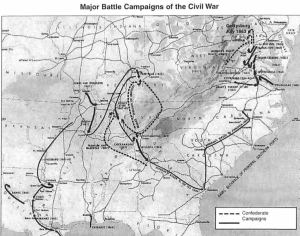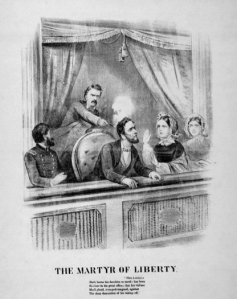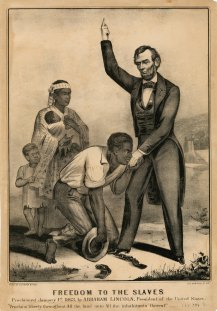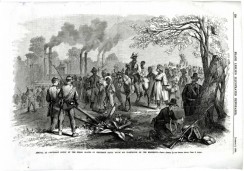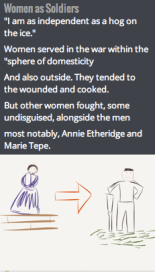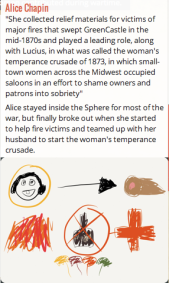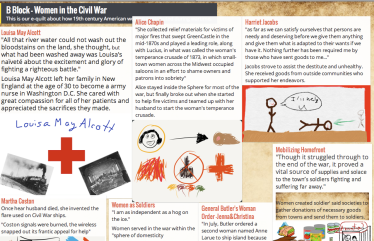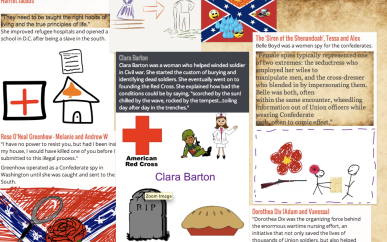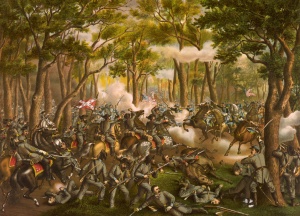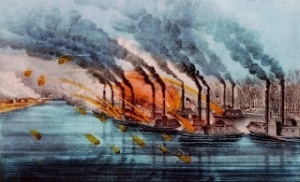As Elie Wiesel once famously stated, “the opposite of love is not hate, it’s indifference.” Since the beginning of time, people across the globe have been doing horrible things to one another– but what if the greatest offence of all was standing by and doing nothing? Yes, the man spreading terror through violence and chaos is far from innocent, but there lies an even greater guilt within the man standing by and letting it happen. This moral dilemma can be found within events, both notable and forgotten, that have occurred time and time again over the progression of history– events including America’s Reconstruction. The Reconstruction, described as the 12 years after the Civil War when efforts were being made to maintain the rights of freedmen, was a time when, in the words of W.E.B. Dubois, “…the slave went free; stood a brief moment in the sun; then moved back again towards slavery.” (BE). Essentially, Reconstruction may have began the fight for equality, but it was a fight that was quickly abandoned. In 1876, the Reconstruction was officially brought to an end through an informal and betraying compromise between President Hayes and the former Confederacy (BE). In this Great Betrayal, Hayes agreed to pull all federal troops out of the south in exchange for his term in office; leaving reconstruction completely in the hands of the people (BE). So, it was the apathy of those people in the North that truly ceased all reconstructive efforts, despite the role of southern terror, because of their resulting lack of concern for the rights of freedmen.
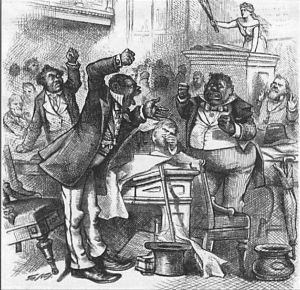
Harper’s Weekly, March 14, 1874.
Northern apathy, being the major cause of Reconstruction’s downfall, was partially derived from people’s own personal prejudices. In the north people may have been against slavery, but that did not necessarily mean that they supported political equality (D). Seeing the blacks as too uncivilized to serve in court, the usually Radical Republican newspaper, Harper’s Weekly, drew the political cartoon shown on the right to emphasise their distinct feelings of superiority (D). Depicting the African American men as wild and ape-like, this drawing says a lot about the northern attitude towards race and equality at the time (D). Surprisingly, considering the northern opinions on slavery, the north was far from seeing the freedmen as equals and thus lost interest fighting with southerners just so the freedmen could maintain their rights.
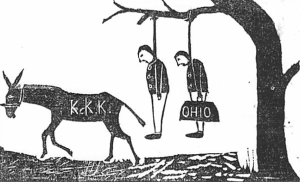
Independant Monitor. September 1, 1868. Alabama Department of Archives and History, Montgomery, Alabama.
As straight-forward as it may seem, the Northern apathy that killed the reconstruction was still not without contributing factors from the South. Since the start of the reconstruction, southern organisations like the Klu Klux Klan did everything that they could to spread terror as a tool to control the black population (A+B). The cartoon on the left is a prime example of this (A). Drawn as a distinct threat for carpetbaggers and scalawags who supported or tried to help the freedmen, this drawing was published into a Klan newspaper, The Independent Monitor, as an attempt to scare the reconstruction away (A). Going beyond simple cartoons to performing violent intimidations and committing public murders, the Klu Klux Klan did everything in their power to keep freedmen from practicing their rights as citizens (B). This constant threat of terror, while playing a significant role in the downfall of reconstruction, was just another reason to fuel the northern disinterest with the south.
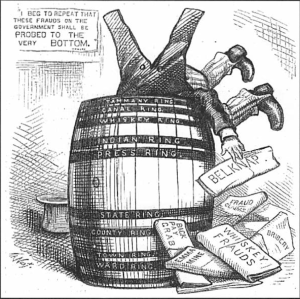
U.S. ‘In For It.’ I hope I shall get to the bottom soon. Harper’s Weekly, 1876.
On top of all this, reconstruction was dying because the people in the north were too distracted with other problems in their society to focus on the freedmen in the south (C). Growing tired of everything to do with the Reconstruction, northerners began to target their energy towards the Panic of 1873 instead (C). Shown in the Harper’s Weekly cartoon on the right, politicians had an endless barrel of issues in front of them, and they could never quite get to the ones all the way at the bottom of the barrel (C). Acknowledging that no politician could possibly solve every issue in the barrel, the northerners made the decision to probe the Reconstruction to the bottom in order to focus on more national concerns (C). All in all, the northerners stopped caring what happened in the south when bigger issues came into the picture.
More than anything else, the Reconstruction was smothered by the lack of northern interest. Yes, southern terror supplied northerners with enough incentive to keep to themselves, but the northerns’ apathy was more a result of their own prejudices and distractions than of their fear. The north killed reconstruction not through action, but through inaction– and through this inaction, many freedmen’s rights and liberties regressed dramatically along with the Reconstruction.
Sources:
BE: Background Essay, Reconstruction Mini-Q. http://www.edline.net/files/_0TGgz_/cac47280575889fe3745a49013852ec4/Who_Killed_Reconstruction_Student_Packet.pdf
A: Albion Tourgee, Letter on Klu Klux Klan Activities. New York Tribune, May 1870.
image: Independant Monitor. September 1, 1868. Alabama Department of Archives and History, Montgomery, Alabama.
B: Abram Colby. Testimony to a joint House and Senate Committee in 1872.
Image: Of Course He Wants to Vote the Democratic Ticket. Harpers Weekly, 21 October 1876.
C: Gerald Danzer et al., The Americans, McDougal Littell, 1998.
image: U.S. ‘In For It.’ I hope I shall get to the bottom soon. Harper’s Weekly, 1876.
D: Heather Cox Richardson, The Death of Reconstruction: Race, Labor and Politics in the Post-Civil War North, 1865-1901. Harvard University Press, Cambridge, Massachusetts, 2001.
image: Harper’s Weekly, March 14, 1874.








